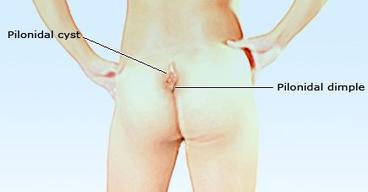Pilonidal cyst, also known as tailbone cyst, occurs at intergluteal cleft (area between two buttock cheeks).
The term pilonidal means nest of hair.
At times, an infection may arise in the cyst resulting in the formation of abscess know as pilonidal abscess.
Cause of the Pilonidal Cyst
Many embryologists consider it as congenital remnants. It is present as a defect at birth in the sacrococcygeal region of the body.
Other argues it to be acquired. The acquired theory proposes that it arises due to prolonged pressure leading to ingrown hair and debris accumulation.
Excessive sweating increases the moisture in the area that promotes the growth of anaerobic bacteria.
It also explains the reason for its high recurrence and development of this disease in the hands of the barber, sheep shearer, and dog groomers.
Risk Factors of the Pilonidal Cyst
Male > Female
Young adults
Excessive hair in the area
Occupations
Drivers (own hair)
Barber (Customer hair)
Dog groomer, Sheep shearer (Animal hair)
Obesity
Poor hygiene
Narrow intergluteal cleft
Family history
Signs & Symptoms
It commonly reports as painful swelling and occasional purulent drainage in tailbone area
Other symptoms are
An unpleasant smell
Blood discharge
Tenderness
A previous history of pilonidal cyst
History of trauma
Fever
Excessive moisture in the affected area
Diagnosis & Treatment
A complete history and physical examination mainly establishes the diagnosis rarely requiring advanced investigations.
Treatment of the pilonidal cyst varies with the severity of the disease.
Patients with relatively minor symptoms require a more conservative approach. Strict hygiene with hair removal usually resolves the issue.
An acute infection of the cyst resulting in purulent drainage needs extra attention. Rest, hygiene modification, antibiotic coverage, and local antiseptic dressings are the key measures.
In some cases, it is necessary to perform an incision and drainage of the cyst removing the debris and granulation tissue under general or local anesthesia.
The chronic form of the disease demands a more aggressive management. A surgeon resects the sinus with the cystic lining under general anesthesia.
Choosing the Right Surgeon
Surgery Group LA (Los Angeles) is a team of board-certified surgeons with a vast experience in pilonidal cysts.
Schedule an appointment with us for the evaluation and recommendations for you or your loved one’s condition so you can make an informed decision.


Recent Comments